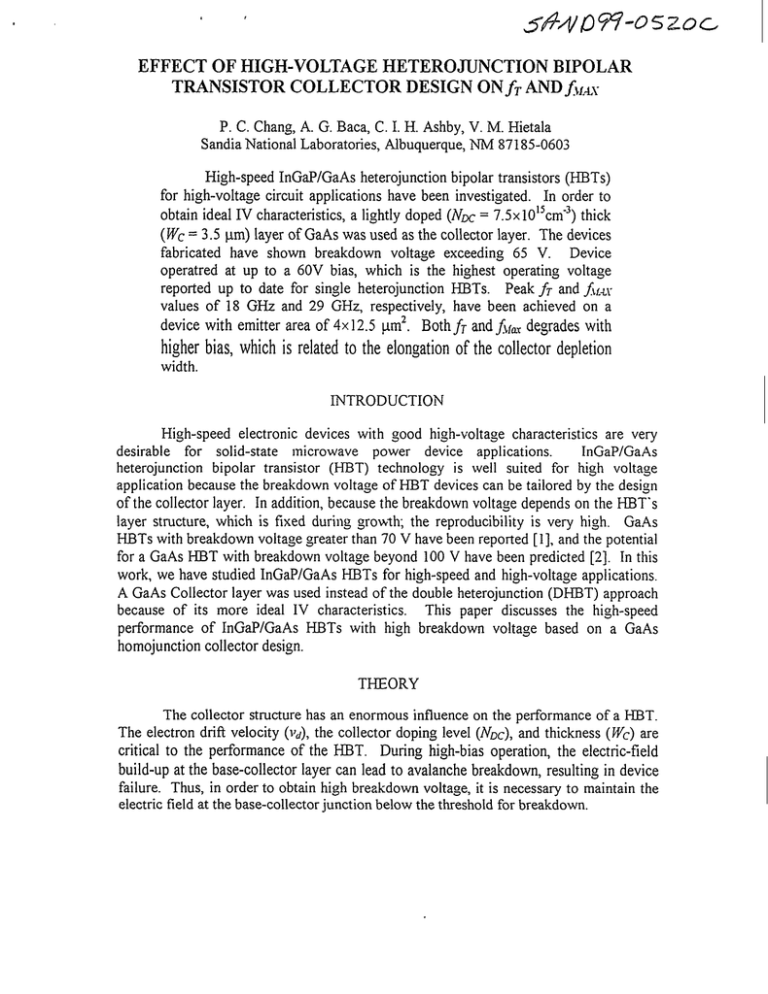EFFECT OF HIGH-VOLTAGE HETEROJUNCTION BIPOLAR
advertisement

EFFECT OF HIGH-VOLTAGE HETEROJUNCTION BIPOLAR TRANSISTOR COLLECTOR DESIGN ONf~ AND f}LLY P. C. Chang, A. G. Baca, C. I. H. Ashby, V. M. Hietala Sandia National Laboratories, Albuquerque, NM 87185-0603 High-speed InGaP/GaAs heterojunction bipolar transistors (HBTs) for high-voltage circuit applications have been investigated. In order to obtain ideal IV characteristics, a lightly doped (Nm = 7.5x 1015cm-3)thick (Wc = 3.5 pm) layer of GaAs was used as the collector layer. The devices fabricated have shown breakdown voltage exceeding 65 V. Device operatred at up to a 60V bias, which is the highest operating voltage reported up to date for single heterojunction HBTs. Peak y~ and ~&+.~ values of 18 GHz and 29 GHz, respectively, have been achieved on a device with emitter area of 4x 12.5 pm2. Both jj- and .j}fLrdegrades with higher bias, which is related to the elongation of the collector depletion width. INTRODUCTION High-speed electronic devices with good high-voltage characteristics are very InGaP/GaAs desirable for solid-state microwave power device applications. heterojunction bipolar transistor (HBT) technology is well suited for high voltage application because the breakdown voltage of HBT devices can be tailored by the design of the collector layer. In addition, because the breakdown voltage depends on the HBT.s layer structure, which is fixed during growth; the reproducibility is very high. GaAs HBTs with breakdown voltage greater than 70 V have been reported [1], and the potential for a GaAs HBT with breakdown voltage beyond 100 V have been predicted [2]. In this work, we have studied InGaP/GaAs HBTs for high-speed and high-voltage applications. A GaAs Collector layer was used instead of the double heterojunction (DHBT) approach This paper discusses the high-speed because of its more ideal IV characteristics. performance of InGaP/GaAs HBTs with high breakdown voltage based on a GaAs homojunction collector design. THEORY The collector structure has an enormous influence on the pefiormance of a HBT. The electron drift velocity (vd), the collector doping level (N~c), ‘and thickness (We) are critical to the performance of the HBT. During high-bias operation, the electric-field build-up at the base-collector layer can lead to avalanche breakdown, resulting in device failure. Thus, in order to obtain high breakdown voltage, it is necessary to maintain the electric field at the base-collector junction below the threshold for breakdown. DISCLAIMER This report was prepared as an account of work sponsored by an agency of the United States Government. Neither the United States Government nor any agency thereof, nor any make any warranty, express or implied, or assumes any legal liability or responsibility for the accuracy, completeness, or usefulness of any information, apparatus, product, or process disclosed, or represents that of their employees, , its use would not infringe privately owned rights. Reference herein to any specific commercial product, process, or manufacturer, or service by trade name, trademark, otherwise does not necessarily constitute or imply its endorsement, recommendation, or favoring by the United States Government or any agency thereof. The views and opinions of authors expressed herein do not necessarily state or reflect those of the United States Government or any agency thereof. DISCLAIMER Portions of this document may be illegible in electronic image products. Images are produced from the best available original document. , In general, wider bandgap material supports ahigher breakdown field, which is desirable forachieving high breakdown voltage. InGaPhas abandgap ofl.92eV while lattice matched to GaAs, and relative to the other wide bandgap materials lattice matched to GaAs, it has a small conduction band discontinuity with GaAs (O.12eV). Much effort has been devoted to developing high-voltage HBTs using InGaP/GaAs/InGaP DHBT technology. However, the conduction band discontinuity at the base-collector junction is high enough to disrupt the current flow during HBT operation [3-5]. A recent effort by Lye et al. has attempted to alleviate this problem by introducing AlGaAs in the base layer to reduce the conduction band discontinuity [6]. The resulting IV characteristic is much improved, but the improvement is at expense of reduced current gain, which is also undesirable. Using GaAs as the collector material would result in almost ideal IV behavior; therefore, it is preferred for the purpose of this work. The design goal is to obtain HBTs with a breakdown voltage greater than 50 V suitable for optoelectronic integration. From Sze et al. [7], it is concluded that the collector doping has to be less than 1016cm-3 to achieve the desired breakdown voltage. At such low doping levels, the collector depletion width grows quickly; thus, the HBT structure would require a thick collector layer to accommodate the collector depletion. Assuming the collector doping level (Nm) is 7.5x1015 cm-3, at V& of 65 V, the collector depletion width would be approximately 3.5 ~m, and the maximum electric field in the collector would be less than 2x105 V/cm, as shown in Fi=wre 1. Thus, a HBT with thick (Wc = 3.5 pm) Ga.4s collector with low doping level (Nx = 7.5x 10’5cm-3)was designed as shown in Fi~re 2. However an adverse effect of this thick collector approach is the degraded 1.E+06 ! — I I l:’ 4 I —— ——— t 4.0 — —— —— . -3.5 :. i ! ‘E : t-f ,.”; i -3.0 ., : 1. I 2.5 ~ IT =. o 2.0:-. n 5 1.E+05 L 1 ! I ji I ;. 1.0 iiii~ 1; ;etiion width! i ;0 !1 vT-: lrMa;miF’e De 0.5 1.E+04 0.0 0 10 20 30 40 ‘C, 50 60 70 M Figure 1: The simulation of the electric field, F, and the collector depletion widt~ Wc, of the high-voltage HBT under applied collector bias. ~uE,nGap(,o_7) Figure 2: Schematic of the high-voltage HBT investigated in this wor~. The base mesa slope is at 10° off vertical to assure metal line B:GaAs (70nrn/4E19) continuity. perllormance. When the device is under low bias condition, the collector depletion width, Wc, is less than 3000& highly energetic electrons would be injected into the collector. The resulting electron overshoot effect would significantly reduce the collector transit time, Tc, where ~c is given by Wc (1) o where v(x) is the electron velocity in the collector. As the collector depletion increases, the electron overshoot has a negligible effect on the reduction of ~c. Electron transport would be dominated by the electron drifi velocity, v& in the collector, which is much slower. In combination with the larger collector depletion width, this would produce a much longer TC, dominating the total electron transient time, ~~c, across the HBT structure. Since the HBT cutoff frequency is defined by 1 = — ‘T 2nT~c ‘~~=+ (~~+ TB‘Tc + TCC)-l- (2) Consequently, HBT rj performance suffers. Another r~ performance benchmark is the maximum oscillation frequency, which is given by JLi’ = d -.k-8TCRBCBC “ (3) Conventionally, it is believed that the reduction in base-collector junction capacitance, CBC,given by cBc=~, (4) would offset the effect of increased ~c, thus resulting in overall improved ~~fir. However, no work has been reported for HBTs with Wc exceeding one ~m. As Wc becomes longer, ~~ becomes increasingly dominated by ~c; so the effects of increased Wc on CBc, and on ~c would cancel. In addition, the electron drift velocity in GaAs reaches a maximum near 5x103 V/cm. Thus, as the electric field increases to greater than 5x103 V/cm, vd in the collector would decrease by as much as 50’?40.This phenomenon is generally negligible in a short collector device, where the overshoot effect would compensate for the reduced Vd. But in the case of a very long collector, it would lead to further deterioration of~~ and~&. An alternative approach is to use a two step collector-doping scheme to reduce the collector depletion width, thus producing a shorter TC. The depletion width reduction can be achieved by inserting a higher doped collector layer near the base-collector junction, because the electric field in the higher doped region would increase rapidly as the collector bias is increased. A lightly doped collector layer beneath the higher doped collector layer would reduce the growing electric field under higher bias. Breakdown conditions would be delayed till the designed voltage. Given a breakdown electric field of approximately 2x105 V/cm for GaAs, an example of this collector design, along with the simulated peak field is shown in Figure 3. As shown in Figure 3, I?’_cwould be approximately 2.8 ~m for 60 V of applied bias. That translates to more than a 20’% improvement of ~c, and improves fT and~u~ correspondingly. 1.E+oij - 3.00 2.50 n AAA 1.E+05 AA ‘D A AAAAAe~ ~– o bA-A- n n u — 2.00 ,. —— ~———~ —— ———_— —————c. -— —-o~ u o 1 ——-—— .— .—— 0 x n – 1.50-= ~ ——. 1.E+04 A Fcal I o I — , (7 I OXd 1 – 0.50 i o I 1.E+03 0 0.00 10 20 30 Vc .#/mwJ?/A-.* 40 50 60 M E:hG.p,,onti,El,) Figure 3: The two step doping collector B:Gw4s (70nm/4E19) (0.5um13.0E16) design that would reduce Wc, thus improving f~and jll~~ while maintaining high breakdown voltage. EXPERIMENT The HBT structure shown on Figure 2 was grown using MOCVD. Devices were then fabricated with our triple mesa HBT process. Because of the particular etch profile that would result from wet etching GaAs, metal continuity would be a problem as it runs over the base mesa step. In order to achieve the desired slope angle around the large step that would assure the continuity of the metal lines, an inductively coupled plasma (ICP) BC13-based process was developed for this work. The etch process produces smooth sidewalls sloped at 10° angle off vertical, as shown in Figure’ 2. The metal contacts used for the emitter, the base, and the collector are WSi, PtTiPtAu, and PdGeAu, respectively. Silicon oxynitride is deposited using a roomtemperature ECR process for device passivation. The device is maintained below 200”C during the whole process. Devices are tested for DC periiormance using HI?4145B semiconductor prameter analyzer. The HBTs have demonstrated ~c~o exceeding 65 V, and VCEOaround 50 V as shown in Figure 4, respective y. The current gain, ~, exceeds 100 with nearly ideal common-emitter IV characteristics for operation up to 25 V as shown in Fi=wres 5 and 6. Device operation with the collector-emitter bias (J’CE)up to 60 V is shown in Figure 6. Device performance at over 25 V bias shows some non-ideal IV behavior due to device heating and high collector resistance, as expected. This is the first demonstration of a single heterojunction GaAs HBT operating at bias over 50 V, and is very promising for high-voltage circuit applications. ~ I t i I I ! 1, 1 I I f ! , I I I ! I ! I 1 0 -1E.07 Figure 4: lb 2il I & h + 60 ;0 The collector-emitter breakdown VCEOis approximately 50 V, W I.E-01 [ ,00 I 1.E-03 80 = ~ 1.E-05 60 _m 03 Q !2) x 1.E-07 40 1.E-09 20 I.E-11 0 0.50 0.70 0.90 1.10 1.30 1.50 Vc M Figure 5: The Gummel plot shows current gain greater than 100, with almost ideal IV characteristics. N4xI 2.5 ~m2 0.0025 ! i I 0.0020 ——. I .-”” 0.0015 ~ _o 0,0010 IB=6UA ( IB:3UA 0.0005 / 0.0000 0 .- ~ I i i 10 20 30 ~cEM 40 50 60 Figure 6: The common emitter IV plot showing the HBT operation up to 60 V of bias. This is the highest operat-ingbias tha~s been dem&strated & a single heterojunction GaAs HBT. The high-speed petiormances of these HBTs are characterized using the HP-85 10 network analyzer. Peak ~~ and ~u~l- values of 18 GHz and 29 GHz, respective y, have been obtained on a device with an emitter area of 4x 12.5 ~m2. The r- performance 30 t 0 I I I I I t CircIes :f,jtLV I Triangles :f~ 25 o ( I I o I A i“ o o 0 n u o o 0 i [ A A I A A 1A I 0 o 2 4 6 A i I 8 ~cE M 10 12 14 16 Figure 7: The ~~performance of the high-voltage HBT as finction of applied bias. Three different curves are shown for each of~r and&.~, each with a different operating current. The top curve for each group has the highest operating current. increases as iimction of increasing current density (Jc), as expected. Both ~~ and Jf.w decrease with increasing collector bias (J&), as shown in Figure 7. This decrease in ~~ performance is expected, as discussed above. As the collector depletion width increases, Vddominates the electron transport and device performance deteriorates. Unlike previous studies with collector widths near one vm [8], i\MX decreases instead of increasing with the increasing V&. The increased dominance of ~c has cancelled out the benefits of fk-. The reduced CBc, and the degradation of vd under high bias h= deteriorated degradation in~\l+r, however, is less severe than the degradation observed inf~, which is because the reduction in CBCdoes offset some of the effect of higher V& CONCLUSION High-speed, high-voltage HRTs with breakdown voltage exceeding 60 V have been demonstrated. The effect of the lightly doped, thick GaAs collector design has been confirmed with theory and experiment. Although ~~ decreases with increasing collector depletion width as expected, ~~.Mxalso decreases in these thick collector HBTs, unlike previous studies with collector thickness less than a ~m. The degradation is attributed to the increasing dominance of -rc in the value of~~, which would offset the advantages gained by CBCreduction. Others factors, such as reduced ~das result of increased electric field would reduce both~~ andj~ti. One approach to optimizing the rj performance of high-voltage HBT operation is the reduction of the collector depletion width. The two-step collector doping design discussed above is one approach that would preserve the ideal IV characteristics of single junction HBT, while reducing ~Cby as much as 20Y0. The effect of the two step collector doping design will be confirmed in fhture studies. . ACKNOWLEDGEMENT Sandia is a multiprogram laboratory operated by Sandia Corporation, a Lockheed Martin Company, for the United States Department of Energy under Contract DE-AC0494AL85000. REFERENCE [1] D. Hill, and T. S. Kin IEEE Transactions on Microwave Zhoery and Techniques, vol. 45, no. 12, pp. 2224-2228, Dec. 1997. [2] D. Hill, Proceedingsof Gals IC Symposium,pp. 149-152,Nov. 1998. [3] J.-I. Song, C. Caneau, K.-B. Chaough, and W.-P. Hong, IEEE Electron Device Letters, vol. 15,no. 1, pp. 10-12, Jan. 1994. [4] F. Ren, C. R. Abernathy, S. J. Pearton, P. W. Wisk, and R. Esagui, Electronics Le/ters, vol. 28, no. 12,pp. 1150-1152, Jun. 1992. [5] Y. F. Yang, C. C. Hsu, and E. S. Yang, IEEE Transaction on Electron Devices, vol. 42, no. 7, pp. 1383-1386, Jul. 1995. [6] B.-C. Lye, P. A. Houston, H.-K. Yew, and C. C. Button, IEEE TFa?7.~acfion 017 EIecfro~7Devices, vol. 45, no. 12, pp. 2417-2421, Dec. 1998. [7] S. M. Sze, and G. Gibbons, Applied Physics Letters, vol. 8, p. 111, 1966. [8] G.-B. Gao, H. Morkoc, and M.-C. F. Chang, IEEE Trm7sac~ion m Electron Devices, vol. 39, no. 9, pp. 1987-1997, Sep. 1987. . KEY . WORDS : Hetrojpnction Bipolar breakdown, GaAs. Transistor, HBT, InGaP, High-voltage, high-speed, high-


